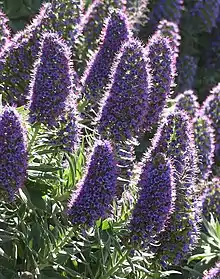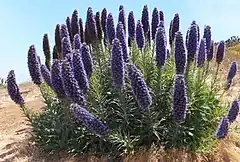Echium candicans
Echium candicans, the 'Pride of Madeira', is a species of flowering plant in the family Boraginaceae, native to the island of Madeira. It is a large herbaceous perennial subshrub, growing to 1.5–2.5 m (4 ft 11 in – 8 ft 2 in).[3]
| Pride of Madeira | |
|---|---|
 | |
| Scientific classification | |
| Kingdom: | Plantae |
| Clade: | Tracheophytes |
| Clade: | Angiosperms |
| Clade: | Eudicots |
| Clade: | Asterids |
| Order: | Boraginales |
| Family: | Boraginaceae |
| Genus: | Echium |
| Species: | E. candicans |
| Binomial name | |
| Echium candicans (L.f., 1782) | |
| Synonyms[2] | |
| |
In the first year after germination, the plant produces a broad rosette of leaves. In the second and subsequent years, more or less woody flowering stalks are produced clothed in rough leaves. The Latin specific epithet candicans means "shining white", referring to one colour form of this species.[4]
Description

It grows as a 1 to 2 meter high shrub, usually with a candelabra-like growth habit. The inflorescences are not on the terminal shoot, but terminally on side shoots. The bark is whitish and peels off the shoots like paper. The short-stalked leaves are lanceolate to ovate-lanceolate and long pointed at the end, they reach a maximum length of about 25 centimeters and a width of 2 to 4 centimeters.[5][6]
The lower leaves are more than five times as long as the upper ones. The adaxial side of the leaf blade (facing the shoot) is dark green, the axial side is slightly lighter green in color with prominent veins, all parts are protruding dense and soft, relatively long, velvety hairy.[5][6]
Inflorescences
.jpg.webp)
Many flowers and bracts are in a dense, narrow, elongated inflorescence, which reach 10 to 25, maximum 47 centimeters in length. The hermaphrodite, sessile flowers are fivefold with a double perianth and are weakly zygomorphic, unlike the flowers of most other genera in the Boraginaceae. They are colored blue or purple, and would appear from spring to summer.[5][6]
The calyx is 4 to 5 millimeters long, green in color without darker veins and hairy, with lanceolate, pointed calyx lobes. The corolla is blue to violet, often with a white stripe on each apex, the flower tube is 9 to 11 millimeters long, the apex is rounded or truncated at the end. The stamens are pink, the anthers whitish. The flower head is large and covered with white or blue flowers having red stamens. The flower head is much visited by bees and butterflies for its nectar.[7][6]
Distribution
The species is autochthonous only to Madeira and is absent from the other islands in the archipelago. It grows relatively frequently there at an altitude of about 800 to 1200 meters in the central part of the island, at the upper end of the altitude range of the laurel forest and in open, heather-like vegetation.[6]
Cultivation
E. candicans is cultivated in the horticulture trade and widely available throughout the world as an ornamental plant for traditional and drought-tolerant, water-conserving gardens. It is particularly suitable for coastal planting. With a temperature requirement of no less than 5–7 °C (41–45 °F), it needs some winter protection in frost-prone areas. It has gained the Royal Horticultural Society's Award of Garden Merit.[8][9]
Invasive species
In California, it is considered an invasive species. It is removed from native plant communities as part of habitat restoration efforts in coastal parks such as the Golden Gate National Recreation Area.[10]
In New Zealand, it is a common garden escapee onto roadside verges and shingle banks throughout the drier parts of both the North and the South Islands.
In the state of Victoria, Australia, it is considered to be a high weed risk and an alert has been posted by the Department of Primary Industries.[11]
References
- Carvalho, J.A. (2017) [errata version of 2011 assessment]. "Echium candicans". IUCN Red List of Threatened Species. 2011: e.T162036A115869493. doi:10.2305/IUCN.UK.2011-1.RLTS.T162036A5538047.en.
- The Plant List: A Working List of All Plant Species, retrieved 6 November 2015
- RHS A-Z encyclopedia of garden plants. United Kingdom: Dorling Kindersley. 2008. p. 1136. ISBN 978-1405332965.
- Harrison, Lorraine (2012). RHS Latin for Gardeners. United Kingdom: Mitchell Beazley. ISBN 978-1845337315.
- D. Bramwell (1972): A revision of the genus Echium in Macaronesia. In: Lagascalia. Bd. 2(1), S. 37–115 (online verfügbar).
- José Augusto Carvalho, Tânia Pontes, Maria Isabel Batista-Marques, Roberto Jardim (2010): A new species of Echium (Boraginaceae) from the island of Porto Santo (Madeira Archipelago). In: Anales del Jardín Botánico de Madrid. Bd. 67(2), S. 87–96, doi:10.3989/ajbm.2239.
- "Echium candicans". Germplasm Resources Information Network. Agricultural Research Service, United States Department of Agriculture.
- "RHS Plant Selector - Echium candicans". Retrieved 23 February 2020.
- "AGM Plants - Ornamental" (PDF). Royal Horticultural Society. July 2017. p. 35. Retrieved 6 February 2018.
- "Echium candicans Profile". California Invasive Plant Council. 2017-03-20. Retrieved 8 December 2019.
- "Pride of Madeira – Echium candicans". Retrieved 20 June 2012.
